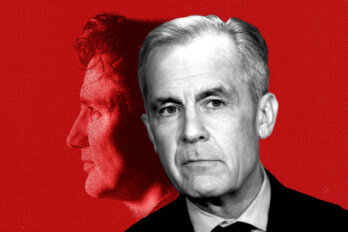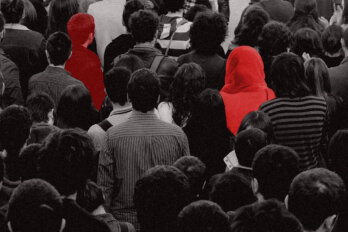Listen to an audio version of this story
Since Russia launched its large-scale invasion of Ukraine on February 24, approximately 2 million people have fled across the border to surrounding European countries. It’s been estimated that, in the coming weeks, that number could grow to more than 4 million, which would make it the largest refugee movement Europe has seen since the end of the Second World War. We asked Christina Clark-Kazak, an associate professor at the University of Ottawa’s school of public and international affairs, what the crisis means for Canada.
When people are displaced, what obligations do other counties have to take them in?
Every human being has the right to claim asylum in another country. This is something that’s found within multiple international conventions. Generally, after someone is granted asylum, the government will determine whether they qualify for refugee status. The process is different around the world, but usually a person needs to demonstrate that it’s not safe for them to return to their country.
The Ukrainian refugee situation is somewhat unique because it’s a European Union–adjacent country, so people can basically travel visa-free within the Schengen Area and neighbouring countries. On March 3, the EU decided to offer temporary protection to refugees fleeing Ukraine, which skips the paperwork and the quasi-judicial process of a hearing to demonstrate whether they meet the requirements for refugee status, allowing them to live and work in EU countries for up to three years. Temporary protection status was introduced after the Balkan wars in the early 1990s, in anticipation of something like the war in Ukraine, but it’s never been used until now.
However, things are more complicated for international students and other non-Ukrainians trying to flee. They don’t necessarily have the same freedom of movement because they would normally require a visa to get into other European countries and don’t qualify for temporary protection. There have already been widespread reports that many African and Asian students are not being allowed to leave. There is also a prioritization of Ukrainian citizens for boarding trains and buses, so there are definitely problems with racism.
Right now, the majority of Ukrainian refugees have been fleeing to neighbouring countries, including Poland, Hungary, and Romania. Could we eventually see some migration to Canada?
The primary destination for people right now is the first safe place, but because of the temporary protection status, there will be secondary migration into other European countries. Ireland, for example, is waiving visas, and there’s huge political pressure on the UK to do so as well. There will also likely be some movement to Canada because there’s a large Ukrainian population here, but this will be in the more medium term.
Is it possible that we’ll also see Russian refugees as a result of the war in Ukraine?
There have already been reports of Russians claiming refugee status. Many have been arrested after coming out on the streets to protest the war. Those people could claim refugee status on political consciousness.
If Russia were to expand its invasion to surrounding countries, what would happen to the Ukrainians who already fled?
There were already people from Afghanistan, Syria, and other conflict areas who came to Ukraine to claim asylum. Those individuals are at very high risk because they don’t have a secure status in the country, and now there’s another displacement happening. If the Russian invasion continues into, say, Poland, then you’ll have refugees who become refugees again.
What bureaucratic hurdles can someone seeking refugee status expect to face, especially when entering Canada?
It’s not yet clear whether Canada will need to be involved in a large-scale refugee resettlement program. There are Ukrainian Canadians with family members in Ukraine and there are huge barriers to bringing them to Canada. Officials are working on expediting applications already in the pipeline as well as the applications from immediate families of Canadian permanent residents or citizens, but this only includes spouses and children, not siblings, grandparents, or other extended family.
For everyone else, Canada has visa policies that it hasn’t yet waived. That process can be incredibly difficult. People have to apply online, which they can do only as long as they have internet access. To confirm the documents, they must then go into a visa office or an embassy. Currently, both the visa offices and the embassy in Ukraine are closed. We had the same problem in Afghanistan and Syria. People had to cross an international border to even access Canadian consular services.
The other major barrier is biometrics. To get a visa, people need to submit a host of medical and other forms, which can be difficult to obtain during times of conflict because offices are closed and it’s unsafe to move. Canada recently introduced temporary measures for Ukrainian nationals to help reduce some of the paperwork, but the regular process still applies to the non-Ukrainians who are fleeing.
Many people will have a passport when they flee because they know they’ll have to cross a border, but they might not have the necessary proof that their child is their child, or of their marital status, or things like that.
How does the current situation compare to the Syrian refugee crisis in 2015?
The refugee determination process is supposed to be a legal administrative process, but the reality is that it’s politicized: different standards and rules apply to different groups and individuals. I’m not suggesting that the Ukrainian situation isn’t a crisis and that people don’t deserve refugee status, but the reception and the opening of borders to them has been fundamentally different from the Syrian refugee arrivals, to whom European countries were proactively closing their borders. Technically speaking, the law applies and should apply to everyone. Practically speaking, it depends on the political and social context.
What’s the economic effect on countries when they take in refugees?
It sounds crass to say, but people often think of refugees as a burden. It can be financially problematic for large hosting states in poorer countries, where people are mostly housed in refugee camps and not integrated into the local community. But, in this context, if integration is done successfully, it can have a net positive impact on the country. As long as people have the ability to work, they won’t be reliant on social services, and that drives economic growth.
What’s your prognosis for the coming months?
It’s unclear to what degree there will be compassion fatigue in Europe. The EU is very gung ho and is promising a lot of support, but the longer the situation goes on, the less resources go toward it and the more support drops off. Just look at Afghanistan. The Taliban took control of the country only six months ago and we’re not really talking about it anymore. Canada promised to take 40,000 Afghan refugees and hasn’t yet fulfilled that commitment.
In the coming years, there will be more displacement from other countries. Canada can’t possibly respond in the same way to every single crisis, even if it should. We just don’t have the resources. It all comes down to political will.
As told to Vanessa Hrvatin. This interview has been edited for length and clarity.




